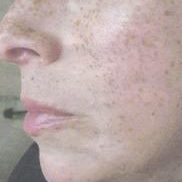Sun damage comes in many forms. Benign forms like freckles and ages spots are a result of a combination of genetic predisposition and sun exposure. People with blond or red hair, light colored eyes and fair skin are more likely to develop freckles as a result of being outside in the sun or from using tanning beds. Natural sunlight and artificial suntanning lights emit ultraviolet (UV) rays. Exposure to ultraviolet rays causes the outer layer of the skin to thicken and the pigment-producing cells (melanocytes) to produce more pigment. That is why sun exposure results in a tanning of the skin. Zinc based sun screens are an absolute must to help prevent this damage.
Of course, people differ a great deal in their reaction to sunlight. People with dark complexions are relatively less sensitive to sun exposure than fair-skinned people. However, dark skinned individuals can become sunburned with prolonged exposure. They also can develop conditions like melasma. Darker skinned individuals can develop skin cancers and melanoma.
Other types of skin lesions can form and may be due to exposure from the sun. Raised scaly brown patches called seborrheic keratoses are often genetic and occur in mainly middle aged and older adults. They can occur anywhere on the body. Seborrheic keratoses vary in size and grow slowly. They usually have a waxy, scaling, or crusted surface. Most SKs are brown but may exhibit other coloring. These lesions are not cancerous but will continue to grow and get bigger. A physician should always be sought out to determine if a funny looking spot is cancerous.

